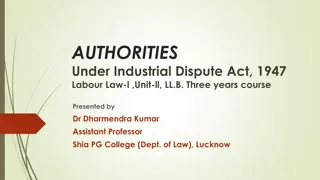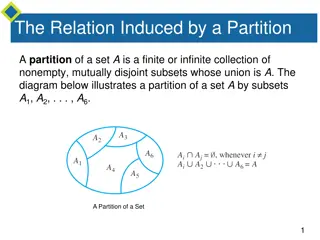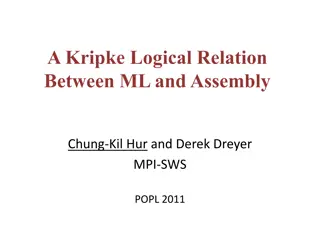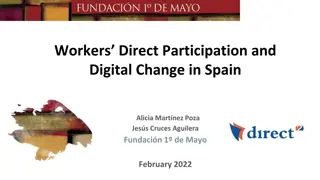Research on Direct Participation and Industrial Relations
The research conducted within the DIRECT framework focuses on direct participation (DP) in Europe, examining its implementation, impact on industrial relations, and best practices. The project involved various partners and aimed to provide recommendations for promoting and enhancing DP at the workplace level.
Download Presentation

Please find below an Image/Link to download the presentation.
The content on the website is provided AS IS for your information and personal use only. It may not be sold, licensed, or shared on other websites without obtaining consent from the author.If you encounter any issues during the download, it is possible that the publisher has removed the file from their server.
You are allowed to download the files provided on this website for personal or commercial use, subject to the condition that they are used lawfully. All files are the property of their respective owners.
The content on the website is provided AS IS for your information and personal use only. It may not be sold, licensed, or shared on other websites without obtaining consent from the author.
E N D
Presentation Transcript
An overview of the research implemented in the An overview of the research implemented in the framework of DIRECT framework of DIRECT main conclusions, recommendations and the way forward recommendations and the way forward main conclusions, Michael Gold DIRECT II CITUB, Sofia: 24 February 2020
DIRECT: Partners DIRECT: Partners The project (2017/18) involved seven partners from six EU Member States: Bulgaria: the Confederation of Independent Trade Unions (CITUB) the contracting partners with the European Commission and overall co-ordinator for the project; and the Bulgarian Industrial Association (BIA) Cyprus: Cyprus Workers Confederation (SEK) Ireland: Institute for the Development of Employee Advancement (IDEAS) Italy: Fondazione Giuseppe di Vittorio (FDV) Poland: Szkola Glowna Handlowa w Warszawie (SGH) United Kingdom: Royal Holloway University of London (RHUL)
Reference Reference The Development of Direct Employee Participation and its Impact on Industrial Relations at Company Level (DIRECT) (VS/2016/0305) 6/12/2016 6/12/2018 Gold, M., O Kelly, K., Ribarova, E. and Atanasova, I. (eds) (2018) Direct Participation in Europe. Comparative Report. Final Report of the DIRECT Project, November (Sofia: Confederation of Independent Trade Unions of Bulgaria). Available at: www.direct-project.org Authors: Ekaterina Ribarova, Kevin O Kelly, Maria Mincheva, Dimitar Brankov, Sylvester Cronin, Tony Murphy, Salvo Leonardi, Evangelis Evangelou, Christos Pelecanos, Michael Gold, Chris Rees and Andrzej Zybala
Objectives of the project Objectives of the project To examine: how social partners understand direct participation (DP) ways it is used by enterprises in two business sectors similarities and differences across these business sectors ways in which direct and representative participation complement each other how DP has (or has not) improved industrial relations in the target enterprises examples of good practice recommendations to national social partners and to EU policy- makers for the promotion and greater use of DP
Definition of Direct Participation Definition of Direct Participation Opportunities provided by management, or initiatives to which they lend their support at the workplace level, for consultation with and/or delegation of responsibilities and authority for decision-making to their subordinates either as individuals or as a group of employees, relating to the immediate work task, work organisation and/or working conditions. (EPOC Project)
Types of direct participation Types of direct participation Direct participation can include both consultative and delegative arrangements in the workplace. These are: Consultative - when management put in place systems for employees to give their views on work-related issues, but continue to reserve the right to decision-making; Delegative - when management give employees greater discretion and responsibility to organise and undertake their work tasks without reference back to management. And such arrangements may be individual or group-based.
CONSULTATIVE DELEGATIVE Regular review meetings between employee and immediate manager Individual employees have the right and responsibility to undertake their work tasks without constant reference back to his/her manager/supervisor Employee attitude surveys Individual Suggestions schemes Other internal arrangements that allow for employees to express their views, through social media, on-line discussion boards, company newsletters, notice boards, etc. Temporaryor ad hoc groups of employees who meet for a specific purpose for a limited period of time such as project groups or task forces Rights and responsibilities are given to groups or teams of employees to carry out their common work tasks without reference back to management - also called group work Group Permanent groups, such as weekly/ monthly meetings of a work team to deal with ongoing work related issues, for example, quality circles
Case studies: manufacturing, services Case studies: manufacturing, services Carlsberg Bulgaria, CocaCola Hellenic Bottling Company (CC-HBC), Sofia airport Charalambides-Christis Dairies Ltd, Cyprus Telecommunications Authority (CYTA) Fleetwood Paints, Bord na M na (BnM) Fiat Chrysler Automobiles (FCA), Intesa Sanpaolo Bank (ISP) BZ WBK (Bank) , Company M (a family enterprise) Toyota Motor Manufacturing Ltd (UK), Leeds Teaching Hospitals NHS Trust
Conclusions Conclusions All forms of DP may be found in varying degrees across all six partner countries, particularly larger companies and subsidiaries of MNCs Most respondents appreciate value of DP, though understandings of it vary No regulatory frameworks, though partial regulation in Bulgaria and Ireland, and some provisions in collective agreements in Ireland and Italy In Italy the social partners, and in Ireland the social partners and government, have been engaged in programmes to improve DP and workplace innovation Success of DP depends on particular forms of work organisation and technology, management style, corporate culture, skills and culture of the workforce, as well as trust and good industrial relations. Role of greenfield sites also significant? DP may have positive impact on management, despite TU concerns over possible negative impacts (e.g. stress, work intensification, relationships within groups)
Conclusions: General summary of social partner views Conclusions: General summary of social partner views DP is restricted to operational, not strategic, issues DP generally introduced at management initiative, hence seen as a management tool (e.g. communications, employee surveys, team briefings) Skills and resources required to make DP work, so it s not just a form of PR TUs accept DP as part of management function, but seek to adapt it to their own agenda, e.g. to enhance skills (through union learning reps and learning agreements) DP seen by TUs to work best alongside TU representation and collective bargaining it is generally not integrated into systems of IR/representation DP may also be delegative, and so potentially transformative - hence surface forms of DP co-exist alongside deeper forms TU concerns over work intensification; management concerns over ability or need of workers to be involved.
Recommendations Recommendations Social partners and State agencies need to consider wider diffusion of DP in light of speed of development of ICT, AI and digitalisation, and workers fears Social partners need to promote good practice at national and sectoral levels, and through EWCs TUs should be more involved in introduction of DP, and managers more so in promoting its benefits and outcomes Managers and TUs should try to co-ordinate different forms of employee representation, including DP, within organisations DP may be a source of information for information/consultation systems TUs should make better use of DP to prepare collective bargaining and prevent disputes (e.g. findings from employee surveys and group consultations).
Digitalisation/AI Digitalisation/AI Variable effects likely Most threatened areas of employment: offices, admin, low-skilled jobs, call centres Strong challenges: retail, banking, farming, health care, publishing For highly skilled work: delimitation of work, intensification, stress, pressures on work/life balance Overall trend to precarity, especially on digital labour platforms Assumptions about employment effects vary widely, so don t deal with the consequences (too late) but get involved at earliest planningstages Forms of employee participation are key.























